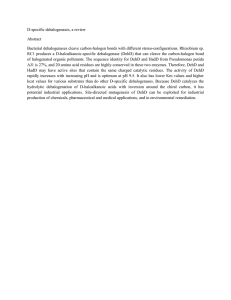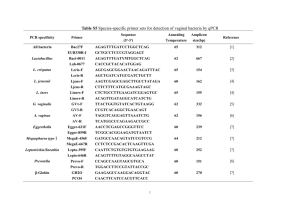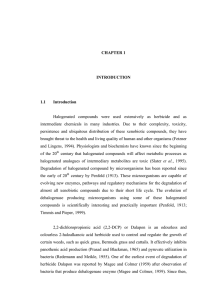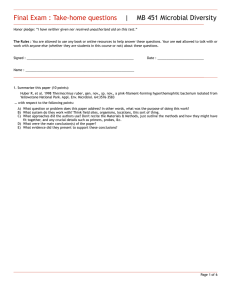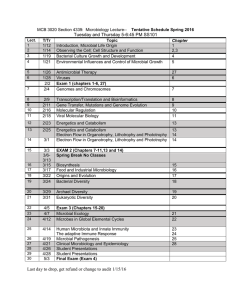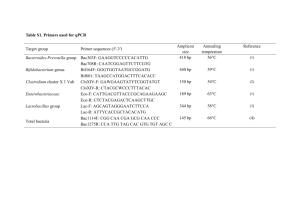REFERENCES Introductory Mycology (4
advertisement
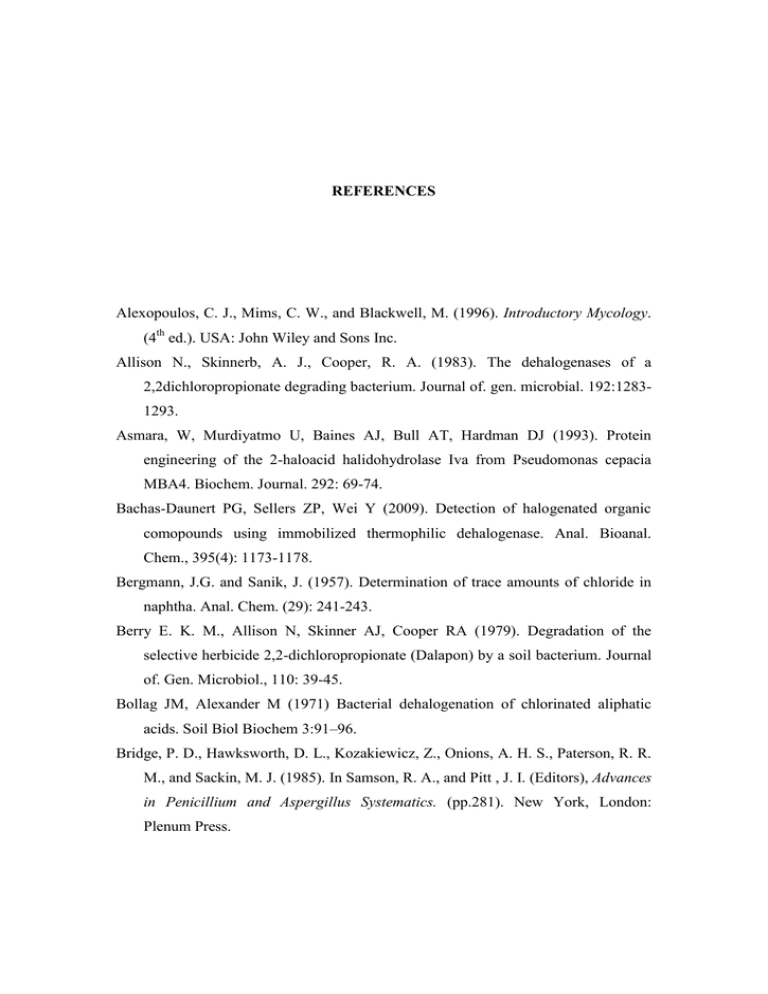
85 REFERENCES Alexopoulos, C. J., Mims, C. W., and Blackwell, M. (1996). Introductory Mycology. (4th ed.). USA: John Wiley and Sons Inc. Allison N., Skinnerb, A. J., Cooper, R. A. (1983). The dehalogenases of a 2,2dichloropropionate degrading bacterium. Journal of. gen. microbial. 192:12831293. Asmara, W, Murdiyatmo U, Baines AJ, Bull AT, Hardman DJ (1993). Protein engineering of the 2-haloacid halidohydrolase Iva from Pseudomonas cepacia MBA4. Biochem. Journal. 292: 69-74. Bachas-Daunert PG, Sellers ZP, Wei Y (2009). Detection of halogenated organic comopounds using immobilized thermophilic dehalogenase. Anal. Bioanal. Chem., 395(4): 1173-1178. Bergmann, J.G. and Sanik, J. (1957). Determination of trace amounts of chloride in naphtha. Anal. Chem. (29): 241-243. Berry E. K. M., Allison N, Skinner AJ, Cooper RA (1979). Degradation of the selective herbicide 2,2-dichloropropionate (Dalapon) by a soil bacterium. Journal of. Gen. Microbiol., 110: 39-45. Bollag JM, Alexander M (1971) Bacterial dehalogenation of chlorinated aliphatic acids. Soil Biol Biochem 3:91–96. Bridge, P. D., Hawksworth, D. L., Kozakiewicz, Z., Onions, A. H. S., Paterson, R. R. M., and Sackin, M. J. (1985). In Samson, R. A., and Pitt , J. I. (Editors), Advances in Penicillium and Aspergillus Systematics. (pp.281). New York, London: Plenum Press. 85 Busto M.D., Smith P.P., Mateos-Perez M., Burns R.G. (1992). Degradation of aliphatic halogen-substituted pesticides by dehalogenase isolated from Pseudomonas alcaligenes. Identification and properties of the enzyme. Sci. Total Environ., 123/124, 267-277. Cairns SS, Cornish A, Cooper RA (1996). Cloning, sequencing and expression in Escherichia coli of two Rhizobium sp. genes encoding haloalkanoate dehalogenases of opposite stereospecificity. Eur. J. Biochem., 253: 744-749. Carlile, M. J., Watkinson, S. C. and Graham. (2001). The Fungi. London UK : Academic Press a Harcourt Science and Technology Company. Commandeur, L.C. and Parsons, J.R.(1990) Degradation of Halogenated Aromatic Compounds. Biodegradation.1(2-3):207-20. Davies, J. L., and Evans, W. C. (1962). The elimination of halide ions from aliphatic halogen-substituted organic acids by an enzyme preparation from Pseudomonas dehalogens. Biochemica1 Journa1. 82, 50. Colquhoun, J.A., Heald, S.C., Li, L., Tamaoka, J., Kato, C., Horikoshi, K., and Bull, A.T. (1998).Taxonomy and biotransformation activities for some deep-sea actinomycetes. Extremophiles, (2): 269-277. El Fantroussi, S., Naveau, H., and Agathos, S. N. (1998). Anaerobic dechlorinating bacteria. Biotechnol Prog. 14: 167-188. Fetzner, S. (1998). Bacterial dehalogenation. Appl. Microbiol. Biotechnol. 50, 633– 657. Fetzner, S. R., Lingens F. (1994). Bacterial Dehalogenases. Microbiol. Rev. 58(4):641-685. Field, J. A., Alvarez, S. R. (2004). Biodegradability of chlorinated solvents and related chlorinated aliphatic compounds. Reviews in Environmental Science & Bio/Technology. (3): 185–254. Fowden, L. (1968). The occurrence and metabolism of carbon halogen compound. Proc. Royal Soc., 171: 5-18. Frisvad, J. C. (1989b) The use of high-performance liquid chromatography and diodearray detection in fungal chemotaxonomy based on profiles of secondary metabolites. Botanical Journal of the Linnean Society 99: 81-95. Goldman, P., Milne, G. W. A. & Keisterd, B. (1968). Carbon-halogen bond cleavage. 111. Studies on bacterial halidohydrolases. Journal of Biological Chemistry 243,428-434. 06 Guarro, J., Gene, J., and Stchigel, M. A. (1999). Development In Fungal Taxonomy. Clinical Microbiology, 11, 1-40. Hardman, D. J. (1991). Biotransformation of halogenated compounds. Crit. Rev. Biotechnol., 11: 1-40. Hardman, D. J, Slater, J. H. (1981). Dehalogenases in soil bacteria. J. Gen. Microbiol., 123: 117-128. Hareland, W. A., Crawford, R. L., Chapman, P. J., and Dagley, S. (1975). Metabolic function and properties of a 4-hydroxyphenyl-acetic acid 1-hydroxylase from Pseudomonas acidovorans. J. Bacteriology. 121: 272-285. Hill, K. E., Marchesi, J. R., and Weightman A. J. (1999). Investigation of two evolutionary unrelated halocarboxylic acid dehalogenase gene families. Journal of . Bacteriol. 181: 2535-2547. Hirsch, P., and Alexander, M. (1960). Microbial decomposition of halogenated propionic and acetic acids. Can. J. Microbiol., 6 (3):241-249. Huyop, F., and Nemati, M. (2010). Properties of dehalogenase from Rhizobium sp. RC1. African Journal of Microbiology Research Vol. 4(25), pp. 2836-2847. Janssen, D. B., Dinkla, I. J. T., Poelarends, G. J. and Terpstra, P. (2005). Bacterial degradation of xenobiotic compounds: evolution and distribution of novel enzyme activities. Environmental Microbiology 7(12), 1868–1882. Janssen, D. B., Oppentocht, J. E., and Poelarends, G. J. (2001). Microbial dehalogenation. Curr. Opin. Biotechnol., 12: 254-258. Jensen, H. L. (1960) Decomposition of chloroacetates and chloropropionates. by bacteria. Acta Agriculturae Scandinavica 10:83-103. Jensen, H. L. (1959) Decomposition of chlorine-substituted organic acids by fungi Acta. Agriculturae Scandinavica 9:421-434. Jensen, H. L. (1957). Decomposition of chloro-organic acids by fungi. Nature, 180: 1416. Jensen, H. L. (1951) Decomposition of chlorosubstituted aliphatic acids by soil bacteria. Can. J. Microbiol. 3:151-164. Jing, N. H., Wahab, R. A. b., Hamdan, S., Huyop, F. (2010). Cloning and DNA sequence analysis of the haloalkanoic permease uptake gene from Rhizobium sp. RC1. Biotechnol., 9(3): 319-325. 06 Jing, N. H., Wahab R. A., Taha A. M., Rashid N. A. A., Huyop AM (2008) A further characterization of 3-chloropropionic acid dehalogenase from Rhodococcus sp. HJ1. Res J Microbiol 3:482–488. Jing, N. H. and Huyop, F.(2007). Dehalogenation of Chlorinated Aliphatic Acid By Rhodococcus Sp. Asia Pacific Journal of Molecular Biology and Biotechnology. 15, 147-151. Jing, N. H., Wahab, R., Cooper R. A., and Huyop, F. (2005). Degradation of herbicide (3-CP) by bacterial dehalogenases. Proc. KUSTEM 4th Annual seminar. 2-5 May. Primula Beach Resort, Kuala Terengganu. Kawasaki, H., Tone, H., and Tonomura, K. (1981). Purification and properties of haloacetate halidohydrolase specified by plasmid from Moraxella sp. strain. B. Agric. Biol. Chem., 45: 35-42. Kwon, O. Y., Ogino, K., and Ishikawa, H. (1991). The Longest 18s Ribosomal RNA Ever Known .Eur J. Biochem. 202,827-833. Lee, R. E. (2008). Phycology (4th Edition).(pp 22-25). USA: Cambridge University Press . Leisinger, T. (1996). Biodegradation of chlorinated aliphatic compounds. Curr. Opin. Biotechnol. 7, 295-300. Little, M., and Williams, P. A. (1971). A bacterial halidohydrolase. Its purification, some properties and its modification by specific amino acid reagents. Eur. J. Biochem. 21:99-109. Marais, J. S. C. (1944). Monofluoroacetic acid, the toxic principle of "Gifblaar" Dichapetalum cymosum (Hook) Engl. Onderstepoort J. Vet. Sci. Anim. Ind., 20: 67-73. Marchesi, J. R., Weightman, A. J. (2003). Comparing the dehalogenase gene pool in cultivated alpha-halocarboxylic aciddegrading bacteria with the environmental metagene pool. Appl. Env. Microbiol., 69: 4357-4382. McConell, G., Ferguson, D. M., and Pearson, C. R. (1975). Chlorinated hydrocarbons and the environment. Endeavour 34, 34-18. McGrath, J. E., Harfoot, C. G. (1997). Reductive dehalogenation of halocarboxylic acids by the phototrophic genera Rhodospirillum and Rhodopseudomonas. Appl. Env. Microbiol. 63 (8): 3333-3335. 06 Mesri, S., Wahab, R. A., Huyop, F. (2009). Degradation of 3-chloropropionic acid (3CP) by Pseudomonas sp. B6P isolated from a rice paddy field. Ann Microbiol 59:447–451. Mohn, W. W., and Tiedje, J. M. (1992). Anaerobic biodegradation of chlorinated benzoates. Microbiol. Rev. 56, 482-501. Morgan, P. and Watkinson, R. J. (1989). Microbiological methods for the cleanup of soil and ground water contaminated with halogenated organic compounds. FEMS Microbiol. Lett. 63, 277-300. Motosugi, K., Esaki, N., and Soda, K. (1982). Purification and properties of 2-halo acid dehalogenase from Pseudomonas putida. Agric. Biol.Chem. 46: 837-838. Nardi-Dei, V., Kurihara, T., Chung, P., Masaru, M., Susumu, T., Soda, K., and Nobuyoshi, E. (1999). DL-2Haloacid Dehalogenase from Pseudomonas sp. 113 is a new class of dehalogenase catalyzing hydrolytic dehalogenation not involving enzyme–substrate ester intermediate. J. Biol. Chem., 30: 20977-20981. Ng, H. J., Roswanira, A., Ronald, A. C., and Fahrul, H. (2005). Degradation of Herbicide (3-Chloropropionic Acid) By Bacterial Dehalogenases. Olaniran, A. O., Babalola, G. O., Okoh, A. I. (2001). Aerobic dehalogenation potentials of four bacterial species isolated from soil and sewage sludge. Chemosphere, 45(1): 45-50. Olaniran, A. O., Pillay, D., Pillay, B. (2004). Haloalkane and haloacid dehalogenases from aerobic bacterial isolates indigenous to contaminated sites in Africa demonstrate diverse substrate specificities. Chemosphere 55(1):2733. Park, C., Kurihara, T., Yoshimura, T., Soda, K., and Esaki, N. (2003). A new D,L-2haloacid dehalogenase acting on 2-haloacid amides: purification, characterization, and mechanism. J. Mol. Catal. B. 23(1):329-336. Paterson, R. R. M. (1986). Standardized One- and Two-Dimensional Thin-Layer Chromatographic Methods for the Identification of Secondary Metabolites in Penicillzum and Other Fungi. Journal of Chromatography. 368, 249-264. Rasul, G. C., and Chapalamadugu, S. (1991). Biodegradation of Halogenated Organic Compounds. American Society for Microbiology 55(1): 59-79. Rittmann, B. and McCarthy, P. (2001). Environmental Biotechnology: Principles and Applocations, McGraw-Hill. 06 Schwarze, R., Brokamp, A., and Schmidt, F. R.. J. (1997). Isolation and Characterization of Dehalogenases from 2,2-Dichloropropionate-Degrading Soil Bacteria. (34): 103–109. Sinha, S., chattopadhyay, P., pan, L., chatterjee, S., chanda, P., Bandyopadhayay, D., Das, K. and Sen, S. (2009). Microbial transformation of xenobiotics for environmental bioremediation. African Journal of Biotechnology.8 (22):60166027. Slater, J. H., Bull, A. T., Hardman, D. J. (1997). Microbial dehalogenation of halogenated alkanoic acids. Adv. Microb. Physiol., 38:133-176. Slater, J. H., Bull, A. T., and Hardmam, D. J. (1995). Microbial Dehalogenation. Biodegradation. 6(3):181-189. Slater, J. H. (1994) Microbial dehalogenation of haloaliphatic compounds. In: Ratledge, C. (Ed.) Biochemistry of Microbial Degradation. (pp 379--421). Dordrecht, Netherlands: Kluwer Academic Publ. Slater, J. H., Weightman, A. J., and Hall, B. G. (1985). Dehalogenase genes of Pseudomonas putida PP3 on chromosomally located transposable elements. Mol. Biol. Evol., 2: 557-567. Slater, J. H., Lovatt,D ., Weightman, A. J., Senior, E. & and Bull, A. T. (1979). The growth of Pseudomonas putida on chlorinated aliphatic acids and its dehalogenase activity. Journal of General Microbiology 114, 125-136. Smit, E., Leeflang, P., Glandorf, B., Elsas, J. D., and Wernars, K. (1999). Analysis of Fungal Diversity in the Wheat Rhizosphere by Sequencing of Cloned PCRAmplified Genes Encoding 18S rRNA and Temperature Gradient Gel Electrophoresis. Applied and Environmental Microbiology. 65 (6): 2614-2621. Song, J. S., Lee, D. H., Lee, K., and Kim, C.K. (2003). Characteristics of several bacterial isolates capable of degrading chloroaliphatic compoundsvia hydrolytic dechlorination . J. Microbiol. 41(4):277-283. Staub, D. K. and Kohler, H. P. E. (1989). Microbial Degradation of β-Chlorinated Four-Carbon Aliphatic Acids. Journal of Bacteriology. 1428-1434. Stringfellow, J. M., Cairns, S. S., Cornish, A., and Cooper, R. A. (1997). Haloalkanoate dehalogenase II (DehE) of a Rhizobium sp. Molecular analysis of the gene and formation of carbon monoxide from trihaloacetate by the enzyme. Eur. J. Biochem., 250: 789-793. 06 Suida, J. F., and De Bernadis, J. F. (1973). Naturally occuring halogenated organic compounds. Lloydia, 36(2): 107-143. Thasif, S., Hamdan, S., and Huyop, F. (2009). Degradation of DL-2chloropropionic acid by bacterial dehalogenases that shows stereospecificity and its partial enzymatic characteristics. Biotechnology, 8(2): 264-269. Towner, K. J. and Cockayayne, A. (1993). Molecular Methods for microbial Identification and Typing. Chapman & Hall. Van Pée, K. H., and Unversucht, S. (2003). “Biological Dehalogenation and Halogenation Reactions.” Chemosphere. 52:299–312. Weightman, A. J., Weightman, A. L., and Slater, J. H. (1982). Stereospecificity of 2monochloropropionate dehalogenation by the two dehalogenases of Pseudomonas putida PP3: evidence of two different dehalogenation mechanisms. J. Gen. Microbiol., 131: 1755-1762. White, T. J., Bruns, T., Lee, S., and Taylor, J. (1990). Amplification and direct sequencing of fungal ribosome RNA genes for phylogenetics. In Innis M. A., Gelfand D. H., Sninsky, J. J., and White T. J. (ed.). PCR Protocols: a guide to methods and applications. 315-322. New York, USA: Acadimic Press. Yan, S., Subramaniam, S. B., Tyagi, R. D., Surampalli, R. Y., and Zhang, T. C. (2010). Emerging contaminants of environmental concern: Source, transport, fate, and treatment. Pract. Periodical Haz. Toxic Radioactive Waste Manage., 14(1): 220. Yokota, T., Fuse, H., Omori, T , and Minoda, Y. (1986). “Microbial Dehalogenation of Haloalkanes Mediated by Oxygenases or Halidohydrolase.” Agricul. And Biol. Chem. 50:453 – 460. Yong W. W. (2010). Isolation, Characterization and Identification of 2,2dichloropropionate deg rading soil microorganism from Melaka rubber estate.Bachelor. Universiti Technologi Malaysia, Skudai. Yu, M., Faan, Y. W., Chung, W. Y. K., and Tsang, J. H. S. (2007). Isolation and characterization of a novel haloacid permease from Burkholderia cepacia MBA4. Appl. Environ. Microbiol., 73(15): 4874-4880.
